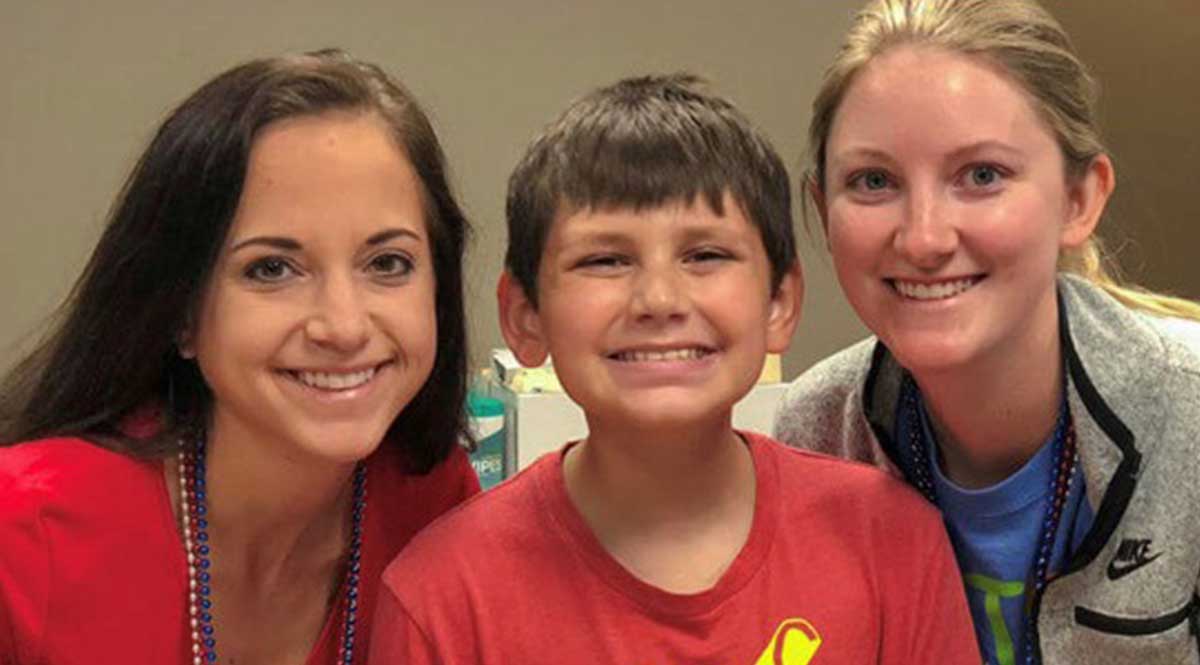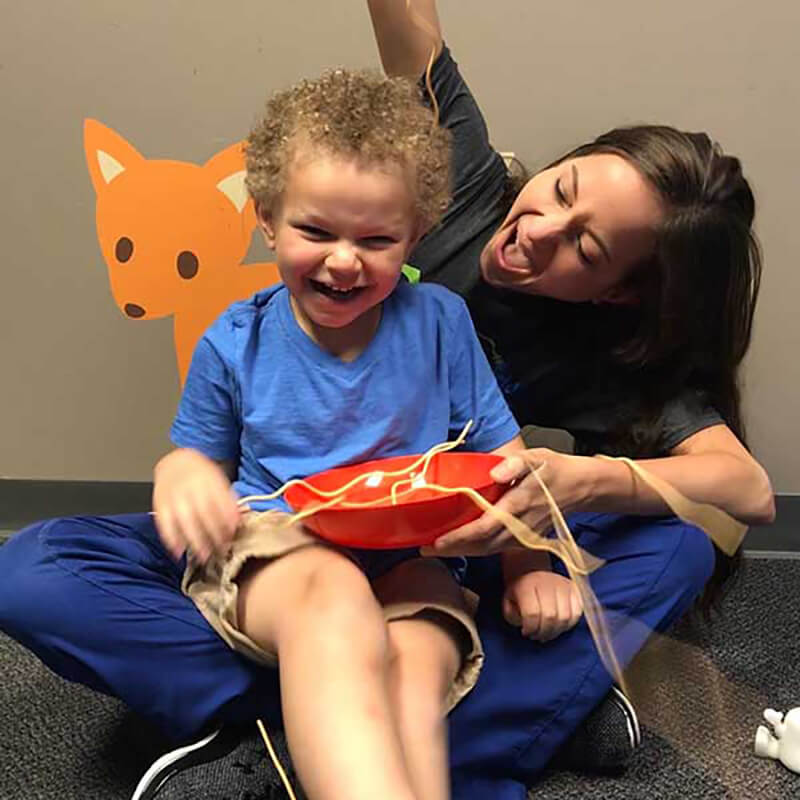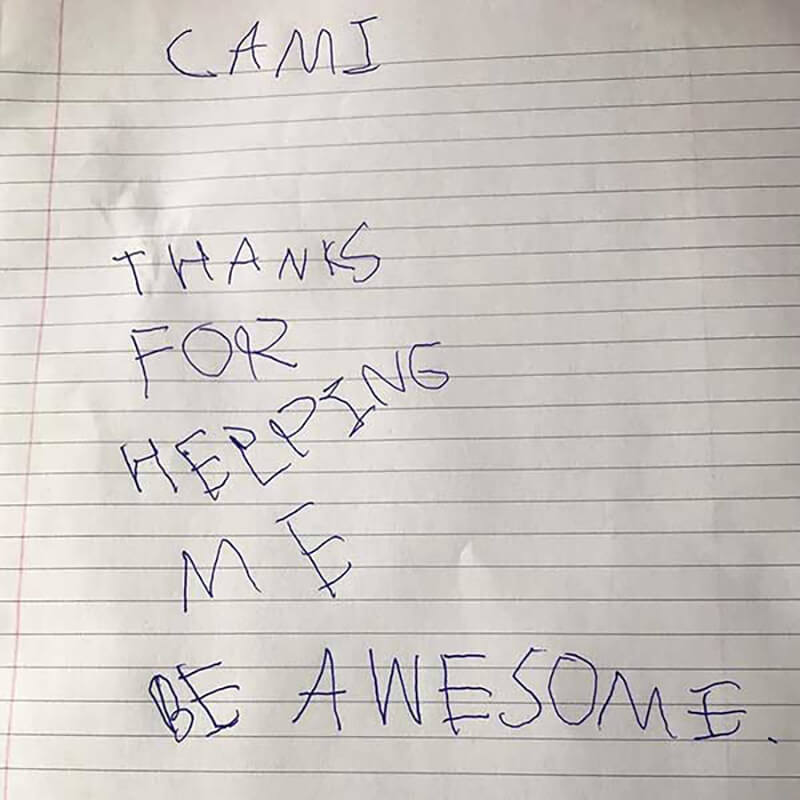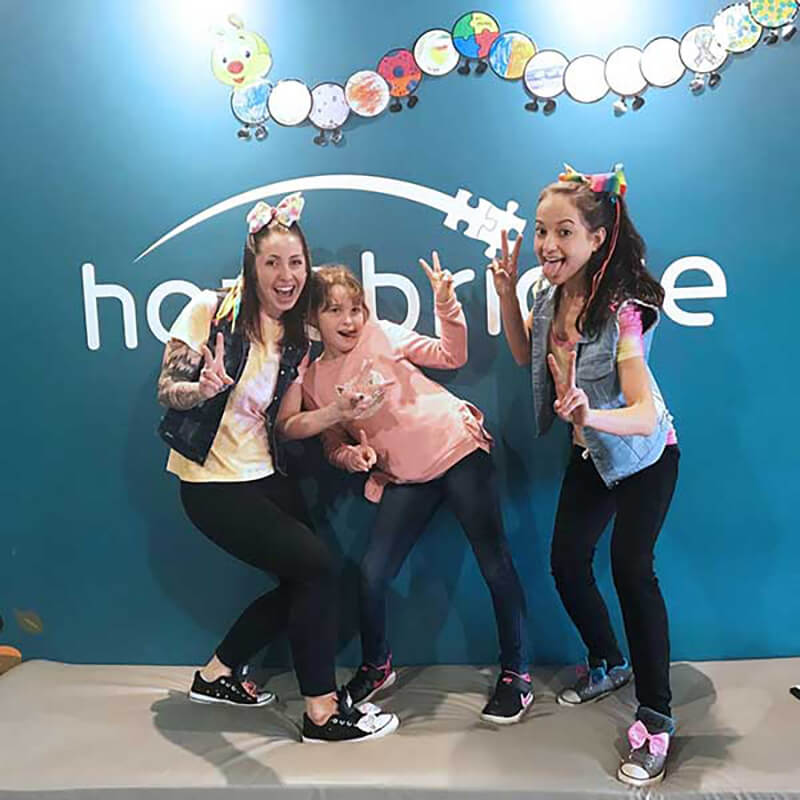Hopebridge’s Cami Gilman Bonds with Autism Families in the Center and through Teletherapy
June 26, 2020
June 26, 2020

Those who work in the world of autism therapy know: all it takes is one person. Whether that individual is a sibling who sparked the motivation to join the field, a friend made in elementary school, or the child who opened your eyes to the power of applied behavior analysis, there is always one who inspires us to do more.
Hopebridge Board Certified Behavior Analyst (BCBA) Cami Gilman met her match while already on the job. At the time, she was fresh out of college with a degree in nutrition and dietetics, but opted for an occupation working with children instead. She took a position as a Registered Behavior Technician (RBT) at a clinic separate from Hopebridge, not fully understanding what she signed up for but thought working one-on-one with kids sounded like fun. She intended for it to be temporary until she could go back to school for her master’s degree in another field.

“It was the most challenging job I ever had and there were days I wanted to quit,” said Cami. “But as I have since learned, we all have that one kid who steals your heart.”
For Cami, that kid was a non-verbal and self-injurious 7-year-old girl who did not make eye contact. For months, Cami worked with her to pick up a tablet and push the word, “eat.” She would prompt her to look at the words and hit the button, but it did not seem to connect. Finally, after tons of sessions, the young girl picked up the tablet independently, looked at it, hit the correct button and looked back at Cami.
“I lost it! I cried and her mom cried. There were months and months of what seemed like no progress, then she finally did it,” said Cami. “I learned to appreciate the little things. What may seem so small was so huge for that family. From that moment on, I decided this was my career. I couldn’t imagine doing anything else.”
Six months later, Cami decided to take it to the next level by mastering in applied behavior analysis (ABA).
“When I started my master’s program, I wanted to be with a company I believed in wholeheartedly,” said Cami. “I did a lot of research on the people who founded the companies in the area and read about Hopebridge’s founder, Kim Strunk. I could tell her goals were based on giving these kids a place to go and doing what’s best for the families, rather than solely focused on money. I was really impressed with Hopebridge.”
Cami began working at the Hopebridge Evansville Center, where she joined the Behavior Analyst Fellowship (BAF) program set up for RBTs who are working toward their graduate degrees. She believes what participants get out of the BAF program all depends on what they put into it. She took advantage of the opportunities presented by the BCBAs in her center and supported them to meet her required hours within six months.
“I got a lot out of the BAF program. At Hopebridge, I had the opportunity of working under four different BCBAs at one time. I picked up different tips and tricks from each one and learned what kind of BCBA I wanted to be, as well as areas I might want to approach a little differently,” said Cami.
When she moved on to become an RBT Fellow, she spent even more time learning the role by doing it under the supervision of Hopebridge’s behavior analysts. She assisted BCBAs with parent training sessions, watching and conducting evaluations, and writing behavior support plans and treatment plans.

Since Cami became a BCBA earlier this year, she has not forgotten her RBT roots. She told us that she originally thought being a BCBA meant making the program decisions and working with others to implement them, but she has since learned the role is more about listening to everyone from the kids (both verbal and non-verbal) to the parents to the RBTs.
“Everything works because of the heart and soul the RBTs put into our centers. I can teach them the techniques, but these therapists truly love these kids, which is what makes the biggest difference in their lives,” said Cami. “Together, we can show that autism is ‘different, not less.’ Not everyone knows how to hear someone on the spectrum, but once you know how to listen, you realize there is so much to say.”
Less than a month after Cami stepped into her new position as a BCBA, the centers temporarily closed due to pandemic-related stay-at-home orders. While her role and responsibilities shifted, she remained in contact with the families. She spent three hours with a family on Easter – virtually, of course – because that was the time that worked best for them.
“The whole world was turned upside-down, but it was especially jolting for these families when we had to close our centers, even for a short time,” said Cami. “Continued communication with the families was rewarding for me; it felt good to be a part of their support system.”
Cami’s goal during this time was to meet families wherever they were at, in a manner that worked for them. Since she was still getting to know some of these families, she offered her time to listen, talk about what was going on in their lives or conduct therapy. There were a number of families who took advantage of the support and telehealth services.
In some ways, tele-therapy helped paint a broader picture and collect more data. Cami was able to watch some of the kids’ behaviors in the home, how their parents responded and how it impacted their overall day. She worked with them to implement tactics like a stoplight system to reward good behavior. She found ways to involve the whole family, such as coaching the child’s siblings through social engagements.

“These families are so invested in their kids and it was amazing to see the parents’ reactions. There were a few occasions when parents didn’t realize their child could do something and I would coach them through it over the telehealth session. They were floored to see their child exhibit a skill they didn’t know was possible,” said Cami.
In addition to the families, Cami made a point to stay in touch with her coworkers and make sure everyone was ok. She said everyone wanted to help, so they dove in to help the center reopen together as a team. Since supplies were difficult to come by for a while, they communicated the basic needs and within a week, they received donations of 500 rolls of toilet paper, hand sanitizer, thermometer, paper towels, disinfectant wipes and more. That’s what we call teamwork at its best!
Now that the clinics are open again, Cami is glad to be back working alongside the children in the center-based therapy environment.
“We get into this field to serve kids with autism and make a difference in their lives, but I never realized they would have such an impact on my own life,” said Cami. “I have no idea what it feels like to have autism, but there is one special child who really connected me to it. I could relate to the way he explained his feelings. Watching the struggles this child overcame was inspiring. If my heart wasn’t already invested in this field, he would have stolen it.”

She looks forward to the days when she and her team members can watch after kiddos during fun Parents’ Night Out events while their families can go have a night on their own. In the meantime, she enjoys helping them all get through their day to day while getting to serve alongside coworkers she says are friends for life.
Are you looking for a way to give back while also advancing your own life and career? Visit our Hopebridge job board to review open positions in ABA therapy in one of our centers across the nation.

Fun Fact: “I figure skate in my spare time. I’m part of a theater-on-ice group, where we put on plays complete with jumps and spins. The contest isn’t to see who is the best skater, but rather who can put on the best show.”
Favorite Superhero: “I’m pretty big into Supergirl; her moral compass is on point. I also like Arrow because he has a good heart.”
Favorite Summer Activity: “I live near the Evansville Riverfront and love taking walks along the river; seeing all the dogs out and hearing the live music. It’s beautiful.”
Favorite Children’s Book: “Good Night Moon.”
*Informed consent was obtained from the participants in this article. This information should not be captured and reused without express permission from Hopebridge, LLC. Testimonials are solicited as part of an open casting call process for testimonials from former client caregivers. Hopebridge does not permit clinical employees to solicit or use testimonials about therapeutic services received from current clients (Ethics Code for Behavior Analysts 5.07-5.08; BACB, 2020). Hopebridge does not provide any incentives, compensation, or renumeration for testimonials provided by a former client or client caregiver.
Team Spotlight
May 30, 2023
Hopebridge Regional BCBA Sam Sardone Finds her “Family” and Clinical Joy by Supporting Other Behavior Analysts
Kiddo Spotlight
July 29, 2025
Five Seconds, Ten Calls, One Conversation: A Story of Advocacy, Identity, and Becoming
Team Spotlight
May 23, 2022
Looking for a Career Change? Hear from Three Therapists who Changed Paths for a Job Serving the Autism Community